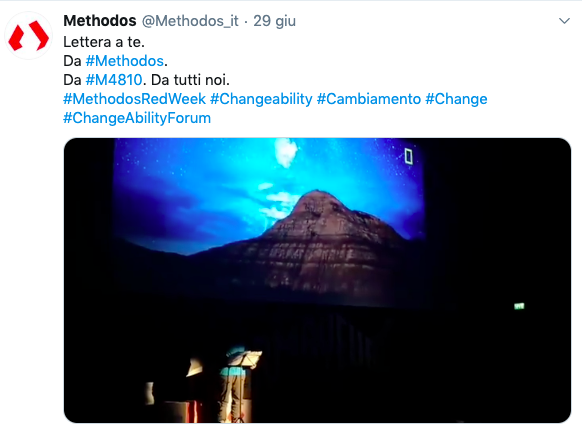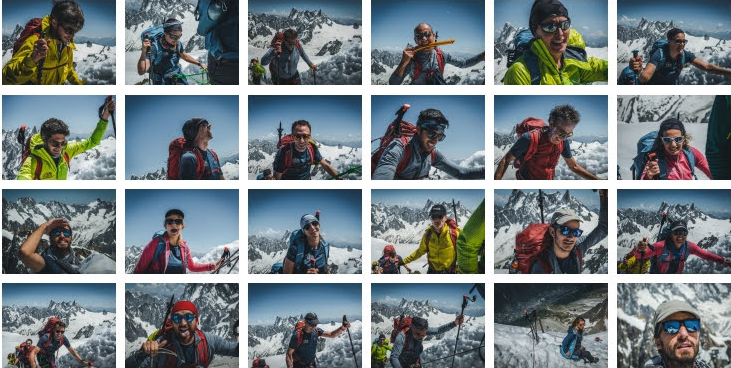
I watch them pass one by one. I can see each face through the lens of my camera for a couple of seconds before it disappears, following along the steep, snowy slope. I observe them through this filter and I can’t help but smile.
We’re at the highest (and most difficult) point of our hike across the Vallée Blanche, metres away from the Aiguille du Midi. We’re only missing a few steps- the hardest ones. This stretch is truly exhausting.
On this steep, vertical crest covered in snow and ice, only the grip of our crampons and our ice axes stops us from falling on one side or the other - hundreds of metres of overhang with a view of Chamonix await.
The couple dozen people that make up the group pass along like on a runway. They have a tense, concentrated, determined look on their face. When they hear the shutter click, they turn, surprised, to look at me, curled up there on the peak to photograph them. While their gaze passes from me to the valley that surrounds us, they wear the most beautiful smiles I’ve ever seen on them: victory smiles, in a challenge against themselves. Those of people that realise they’ve done something they thought was impossible.
And, in turn, I smile, thinking that there couldn’t be a better way to close off this week that was dedicated to change. To celebrating 40 years of Methodos.
It’s truly been a Methodos Red Week.
A red week also for the mercury in the thermometer that, even in Courmayeur, reached over 30 degrees.
But what really sparked excitement in this town at the foot of the Mont Blanc was the anticipation in the air. Dozens of people wearing their RedPeople tags, running up and down the steep mountain hills moving red chairs, signs, microphones, and equipment.

A golf challenge sets in motion the week’s first events: Red Pages, presentations of stories about challenge, resilience, change. The first, set among the peaks that host us, was Due Montanari (Two Mountaineers) by Maria Teresa Cometto: the true story of two brothers and their relationship with, and among, the mountains. The other - unfolding of the recent history of change in Italy - was The Red Side of Change, the book written on the occasion of the 40th anniversary of Methodos.
These events brought us to the headlining event of the Red Week: the Changeability Forum.
In the low light of the Courmayeur cinema, one after the other, extraordinary speakers have the word on the stage. From the compelling Alberto Carnevale Maffè to Don Antonio Loffredo, priest of the the Rione Sanità quarter of Naples. From professors like Giorgio Scagliotti, to travellers like Elena Sacco. From those that don’t let their disability stop them, like Sofia Righetti, to those that, like Maurizio Cheli, choose the top of the world as a personal challenge. They share their personal stories, show us images of what change really is: the ability to go beyond, to see the opportunities in the world. The ability “not to jump higher, but to redefine the techniques for success.”
And then, when the lights go out and the voices of two of our people, hooded and anonymous, resonate, telling stories of change in M4810, few can hold back the tears.
“Maybe we shouldn’t draw conclusions before we reach the destination. But I’m savouring every single moment of this journey. And this is what I want to share with you.”

When the lights are turned on again and the audience breaks into applause, especially the group of over 60 Methodos colleagues that joined from all over Italy - and even from abroad - to participate in this week of change, we all feel enriched from this unique experience. Maybe this is what Methodos calls the “Red Side”.
It’s with this spirit that the morning after we begin walking towards our respective challenges: the two groups are bigger than ever, with all of Methodos - even those who don’t usually participate - in Courmayeur.
The explorers, as the second group called itself, this time includes interns and new colleagues, and tests the inclusivity of this project, now that it’s taken on a double track. Their challenge (and that of the team) will be to respect individual limits without losing vision of the change and continuous improvement that the M4810 project pushes us towards. Different paths to the same goal.
To reach it, the day’s trip leads to the Bonatti hut and then to the Bertone hut, a panoramic 17km path that faces the Mont Blanc and reminds us that we’re all in on the same challenge. Dividing the group allowed us to create exactly what we were missing: a common pace, an equally stimulating challenge for everyone. At the end of the hike, the feeling is unanimous: everyone feels ready to raise the bar, a step at a time, together.
The other group, instead, is going to undertake another challenge: the first glacier crossing.
400 metres to climb, from 3400 to 3800 metres. It sounded like a breeze, but by now we know how it works: just when we think it will be easy, the mountain puts us to the test.
We leave, split into groups, linked by the rope that represents an obligation as much as it is a source of security. This time, we’re all equipped: the sharp shape of our ice axes hanging from our backpacks.

Our slow progression on the ice, which brings us to 4000 metres of altitude, helps us understand how fascinating but insidious the mountain environment can be. The ice breaks next to our feet, revealing every shade of blue – cracks that can be hundreds of metres deep and hide under invisible bridges of snow. It’s beautiful and terrifying.
As if it heard us, the mountain, at a certain point, decides to remind us of its strength. I hear a dull rumble, like a helicopter approaching. Except that there isn’t one in sight.
We turn our heads in unison, just in time to see a small avalanche start next to us, making a threatening sound on its way down towards the valley. Towards our yellow and blue clad colleagues that follow not far away. It was, literally, a moment that took our breath away. Then, as quickly as it started, it ended. Should we be scared? Are we risking it? These are the thoughts that accompany us like a black cloud. The guides help us calm down: the path needs to be followed exactly because it takes into account these risks. But as much as this is true, the message is clear. The mountain demands respect, and it needs to be faced with extreme preparation.

We go up and down, up and down, with the Mont Blanc observing us from a distance. We see small, dark points trying to climb its slopes, and for the first time we can actually see what it means to reach the top of Europe. And then we get to a wall of snow: from here we just have to climb. Aiguille du Midi, our destination, where we’ll take the gondola towards Italy, is a couple of hundred metres vertically above us.
Obviously, the mountain played the usual trick on us: on paper, the climb is 400 metres, but we’ve done a few hundred downhill, and the real climb is closer to 800 metres.
We’re almost there not, and we’ve learned the trick: one, two, one, two… a slow but steady pace, no stopping, no giving in. I focus on my feet and try to avoid glancing at the way to go. One, two, one, two.
Maybe this is exactly why I don’t realise how narrow the crest we are walking on is until we get to the top of it. On my right, there is no land in sight from where I stand to the green of Chamonix, at 1035 metres. On my left, a long overhand of snow and rock would bring me just as low. I hang on to my ice axe as much as I can and I push. This tool, planted in the ice like a walking stick changes my hypnotic pace: one, two, three, one, two, three, one, two, three… we’re so high up!
Metres away from the hut I stop and lock myself in to wait and for the other climbers to pass: it’s the perfect place.
It’s the perfect place to capture it, to see it painted on the faces of those around me.
Yes, that, the thing we’ve been looking for up and down these mountains: change.
The essence of challenge, of overcoming our own limits.
That half smile… afraid, surprised, in disbelief, and victorious, that I continue to see in those that pass me by.
Click-click.

We all meet up again in the valley, a few cable car rides later, where we observe the incredible beauty of the landscape and the length of the route that we walked.
As usual, while savouring a beer and a bite to eat, we share our reactions to the outing.
Disbelief reigns. Disbelief of the difficulty of the final stretch, that challenged even the most well trained. Disbelief of the fear, the height, the ice. But, above all, disbelief of ourselves, for having made it.
“I overcame a limit that I never thought I’d even try to overcome,” whispers Elena as she shakes her head.
Come sempre, però, al momento del debrief vengono fuori anche le nostre mancanze: ci serve la tecnica. Non ci basta avere una piccozza nello zaino, ci serve saperla usare nel caso di una caduta. Ci serve averlo provato, e aver visto che riusciamo a fermarci. Il coraggio è quella cosa che si trova all’incrocio tra la volontà e la sicurezza nelle proprie capacità.
As always, during the debrief, our shortcomings emerge. We need technique. It’s not enough to carry an ice axe in our backpack – we need to know how to use it in case we fall. We need to experience it in order to know that we’re capable of using it to break. Courage is that thing that lies at the crossroads between willfulness and confidence in our own capacities.

The we need awareness. Awareness of our personal limits, and of where we want to stop. But in order to evaluate this, we need to be aware of the journey. And its up to each of us to study and prepare for the next outing – not just from the physical point of view. We have all the tools to do it.
Like in Change Management, there are no alibis, no “I didn’t know what I needed to do to change”. It’s everyone’s responsibility, an individual push to do our research and to prepare ourselves, while the collective push guides and supports us.
One thing, however, gets clearer every time: maybe, had they known what was waiting, some of those that participated today wouldn’t have even tried.
Even though they all did it – no exclusions.
And maybe this is the climax of that change that we observed from all angles during this extraordinary Methodos Red Week.






